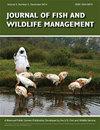美国暴露于人为活动的秃鹰筑巢成功
IF 0.9
4区 环境科学与生态学
Q4 BIODIVERSITY CONSERVATION
引用次数: 0
摘要
对全球景观的人为压力正在迅速增加,对鸟类种群的负面影响有充分记录。美国白头海鹰(halaeetus leucocephalus)的数量自20世纪下降以来,一直在急剧增长,这是一个令人鼓舞的反例,它们现在在人类活动频繁的地区繁衍生息。人类活动对筑巢秃鹰影响的证据好坏参半,一些研究报告称繁殖减少,而另一些研究表明繁殖相对不受影响。我们通过收集美国鱼类和野生动物管理局颁发的白头鹰偶然捕获许可证的数据,评估了人为活动对白头鹰巢成功的影响。我们在贝叶斯框架中使用广义线性逻辑回归模型来评估人类活动类型(n = 6)与巢周围环境中人类发展水平(n = 5)之间的关系,以及人类活动是否导致周围栖息地的显著改变。郊区发放的筑巢许可证(40%)多于自然环境(12%)或工业环境(9%),近一半(47%)的许可证用于建筑活动;栖息地被改变(46%)或未改变(54%)的许可数量相似。在103个筑巢季节的授权活动中,总体平均筑巢成功率为84%(95%可信区间:76-90%),在协变量内的所有类别中,筑巢成功率同样高(77-100%)(p > 0.6)。最上面的模型没有固定效应,占模型集权重的47%,接下来的三个模型包括活动类型和栖息地变化协变量,是其他具有广泛适用信息标准权重的模型。唯一95%可信区间为零的参数是基础设施和景观改造活动,所有暴露于这些活动的巢穴都是成功的;然而,这些估计也有很高的不确定性。这表明我们测试的协变量是巢成功的弱预测因子。在一些获准筑巢的年份之前或之后进行了监测,在活动年份和非活动年份之间筑巢成功率没有显著差异。我们提供了进一步的证据,证明在人类开发的环境中筑巢的秃头鹰的数量越来越多,在一定程度上容忍了人为活动,它们能够以与美国一般人口相当的速度成功筑巢。该研究提高了我们对秃鹰在人类活动下繁殖性能的认识,并将为该物种的管理提供更好的指导。本文章由计算机程序翻译,如有差异,请以英文原文为准。
Nest Success of Bald Eagles Exposed to Anthropogenic Activities in the United States
Anthropogenic pressures on the global landscape are rapidly increasing, with well-documented negative impacts on avian populations. As an encouraging counterexample to general declines, the bald eagle Haliaeetus leucocephalus population in the United States has continued to grow dramatically since its 20th century decline, with breeding pairs now colonizing areas with high levels of human activity. Evidence of the impact of human activity on nesting bald eagles is mixed, with some studies reporting declines in reproduction, while others suggest reproduction is comparatively unaffected. We assessed the effects of anthropogenic activities on bald eagle nest success by compiling data from bald eagle incidental take permits issued by the U.S. Fish and Wildlife Service for unintentional disturbance of breeding bald eagles. We used generalized linear logistic regression models in a Bayesian framework to evaluate the relationship between types of human activity (n = 6), levels of human development in the environment around nests (n = 5), and whether or not the activity resulted in a significant alteration of the surrounding habitat. There were more permits issued for nests in suburban (40%) than in natural (12%) or industrial (9%) environments and nearly half (47%) of the permits were for building activities; there was a similar number of permits where the habitat was altered (46%) or unaltered (54%). Overall mean nest success during authorized activities from 103 nest-seasons was 84% (95% credible interval: 76–90%) and nest success rates were similarly high (77–100%) for all categories within covariates (p > 0.6). The top model was without fixed effects, accounting for 47% of the model set weight, and the next three models, the only other models with widely applicable information criterion weight, included the activity type and habitat alteration covariates. The only parameters with 95% credible intervals encompassing zero were infrastructure and landscape modification activities, for which all nests exposed to these activities were successful; however, these estimates also had very high uncertainty. This indicates that the covariates we tested were weak predictors of nest success. Some permitted nests were monitored prior to or following years of authorized activity, and there was no significant difference in nest success between activity and non-activity years. We provide further evidence that the growing contingent of bald eagles nesting in human-developed environments tolerate anthropogenic activities to a degree that they are able to nest successfully at rates comparable to the general U.S. population. This study improves our understanding of bald eagle reproductive performance when exposed to human activities and will provide better guidance for managing this species.
求助全文
通过发布文献求助,成功后即可免费获取论文全文。
去求助
来源期刊

Journal of Fish and Wildlife Management
BIODIVERSITY CONSERVATION-ECOLOGY
CiteScore
1.60
自引率
0.00%
发文量
43
审稿时长
>12 weeks
期刊介绍:
Journal of Fish and Wildlife Management encourages submission of original, high quality, English-language scientific papers on the practical application and integration of science to conservation and management of native North American fish, wildlife, plants and their habitats in the following categories: Articles, Notes, Surveys and Issues and Perspectives. Papers that do not relate directly to native North American fish, wildlife plants or their habitats may be considered if they highlight species that are closely related to, or conservation issues that are germane to, those in North America.
 求助内容:
求助内容: 应助结果提醒方式:
应助结果提醒方式:


